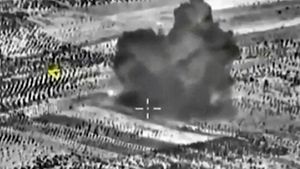As reported worldwide last week, Russia has started bombing a range of targets in Syria. The main purpose of this intervention is to prop up Bashar al-Assad’s flagging regime, which has been under siege by the Islamic State, western-backed rebels, and al-Qaeda- affiliated groups, such as the al-Nusra front. Looking at Bellingcat’s report and images of the Bassel al-Assad airbase at Latakia, we can discern that Moscow has deployed at least 12 fighter-bombers (SU-25 Frogfoot.) (The BBC claims that at least 20 jets have been deployed to Syria.) Dave Majumdar at The National Interest also reports that Russia has deployed 10 SU-24M2 Fencer and four SU-34 Fullback.
According to the Russian government, these planes are supposed to provide close air support for Assad’s troops fighting IS. However, Washington has accused Moscow of also striking rebel groups affiliated with the western-backed Free Syrian Army. (The Russian Ministry of Defense has released drone videos showing airstrikes against IS; you can see them here.)
Russia has apparently also deployed attack helicopters to Syria. According to an unconfirmed photo, this includes one of Russia’s most heavy-hitting choppers, the Mi-24, nicknamed “the flying tank.” Dmitry Adamsky just published a great article in Foreign Affairs laying out what this might mean for Russia’s foreign policy.
Interestingly, the Bellingcat photos also show that Russia appears to have deployed several SU-30M Flankers. These aircraft can be used for air-to-ground attack missions, but are also superb air superiority fighters. As none of Assad’s enemies have aircraft of their own, the question is whether these planes are there as a deterrent against a deepening U.S. involvement in the conflict. Future information on whether the Flankers in Latakia are equipped with air-to-air weaponry will be of great interest.
Russian unmanned aerial vehicles (UAVs) have apparently also been deployed to Syria. According to the Daily Beast, U.S. officials have confirmed that Russian UAVs operating from Latakia are conducting reconnaissance missions in preparation for air strikes. Furthermore, photos apparently taken by members from the al-Nursa front in Idlib Province show UAVs consistent with the outline of the Pchela-1T, or its similar predecessor, the Shmel-1.
There is also some evidence that Russian ground troops are joining the fight. Although Moscow has officially denied that it has deployed ground troops into combat zones, there is an increasing amount of evidence suggesting that this is the case. (Officially, Russia does have a small number of personnel stationed at its naval depot in Tartus.) An increasing number of pictures, including selfies, that seem to have been posted by Russian troops in Syria, are being shared on social media sites such as Facebook and the Russian site Vkontakte. According to these profiles, compiled by Russian blogger Ruslan Leviev, these personnel are members of the crack 810th Independent Marine Brigade, based in Sevastopol.
Many of these pictures are geolocated. That means that the location showing where a picture is taken is tagged to the picture itself. Several pictures were geolocated to the Russian installation in Tartus, which would be in line with official Russian policy. (It should be noted that Russian government spokesmen have previously claimed that all Russian personnel had been evacuated from Syria when the fighting intensified in 2012, and that the base was “not important.”) However, several pictures were geolocated to Homs, a province which has seen much fighting between the Free Syrian Army, the al-Nusra Front, and Assad’s forces.
Furthermore, there has been some interesting leaked YouTube footage. In one particular clip, showing fighting north of Latakia, what sounds like Russian voices can be heard. (However, due to the bad sound quality of the clip, this hasn’t been confirmed.)
The same clip contains footage of a Russian BTR-82A IFV armed with a 30mm 2A72 autocannon. While Assad’s forces have been supplied with large amounts of Russian kit, this IFV/cannon combination is a rare sight even in the Russian military. Furthermore, the vehicle is marked with Russian military markings, which is not normal for the standard BTR-80s previously delivered to Assad’s forces.
This evidence might be circumstantial. There is no hard evidence that Russian troops have participated in ground combat operations just yet. Even if the voices heard in this clip were proven to be Russian, it is still possible that these are mercenaries fighting for Assad. This has been the case previously, although the extent to which these mercenaries have Moscow’s blessing and backing is uncertain.
What is certain is that Russia is raising the stakes in Syria, big time.

































